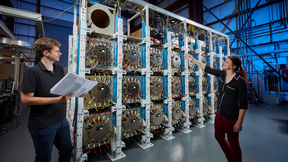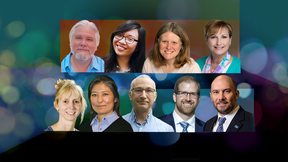Back
Threat preparedness
Inside the Lab: Meet the team protecting America from nuclear threats
In the latest episode of its “Inside the Lab” YouTube series, Lawrence Livermore National Laboratory (LLNL) is featuring the Radiological Assistance Program (RAP), offering a rare look at how national laboratory scientists support high-stakes nuclear and radiological emergency response operations. Watch the episode here. RAP is part of the U.S. Department of Energy’s…
LLNL scientists explore real-time tsunami warning system on world’s fastest supercomputer
Scientists at Lawrence Livermore National Laboratory (LLNL) have helped develop an advanced, real-time tsunami forecasting system — powered by El Capitan, the world’s fastest supercomputer — that could dramatically improve early warning capabilities for coastal communities near earthquake zones. The exascale El Capitan, which has a theoretical peak performance of 2.79…
Big Ideas Lab podcast visits the Forensic Science Center: part 2
Lawrence Livermore National Laboratory’s Forensic Science Center (FSC) is a unique place. It is the only forensic science center in the United States that could accept a truly mixed hazard sample — with a biological material, a chemical agent, explosives and nuclear material. It is one of only two laboratories in the United States — and among 30 in the world — that is…
Protecting the planet: Big Ideas Lab Podcast highlights LLNL’s mission to stop asteroids
In the next two episodes of the Big Ideas Lab Podcast, Lawrence Livermore National Laboratory (LLNL) explores the fascinating and high-stakes world of planetary defense. The episodes explore the science, technology and international collaboration required to detect, track and deflect asteroids that could pose a threat to Earth. Part two is now available on Apple or Spotify…
LLNL's Buddemeier named to National Academies board
Lawrence Livermore National Laboratory (LLNL) certified health physicist Brooke Buddemeier has been appointed to a panel of the National Academies of Sciences, Engineering and Medicine. A 35-year Lab employee, Buddemeier has been named to the Nuclear and Radiation Studies Board (NRSB), which provides advice about safety, security, technical efficacy and other issues…
Franklin Miller awarded Livermore’s 2024 John S. Foster Medal
Lawrence Livermore National Laboratory (LLNL) Director Kim Budil today announced that the 2024 John S. Foster, Jr. Medal is awarded to Franklin Miller, a principal at The Scowcroft Group. The ninth recipient of the prestigious Foster Award, Miller is recognized for his exceptional and inspirational career dedicated to national security, defense policy and international…
Lab team surveys Site 300 for hotspots
In the mid-afternoon of Saturday, June 1, the Corral Fire ignited near the Lab’s Site 300. It made headlines for days and kicked off this year’s fire season. The blaze raced across more than 14,000 acres in just 24 hours, incinerated a structure and badly burned two fire personnel. Early Sunday morning, the Lab’s Associate Principal Deputy Director Sandra Brereton reached…
When experiments go quiet: maintaining the National Ignition Facility
For two weeks last April, the lasers at Lawrence Livermore National Laboratory’s National Ignition Facility stopped firing. Experiments may have been on pause, but the facility was anything but quiet. “To do world-class science, you need a world-class facility. And you can’t just maintain that facility, you must anticipate problems and seek out improvements,” said Stanley…
Signal and image science community comes together for annual workshop
Nearly 150 members of the signal and image science community recently came together to discuss the latest advances in the field and connect with colleagues, friends and potential collaborators at the 28th annual Center for Advanced Image and Signal Science (CASIS) workshop. Held at the University of California Livermore Collaboration Center (UCLCC) for the first time, the…
LLNL and BridgeBio announce trials for supercomputing-discovered cancer drug
In a substantial milestone for supercomputing-aided drug design, Lawrence Livermore National Laboratory (LLNL) and BridgeBio Oncology Therapeutics (BridgeBio) today announced clinical trials have begun for a first-in-class medication that targets specific genetic mutations implicated in many types of cancer. The development of the new drug — BBO-8520 — is the result of…
DOE, LLNL take center stage at inaugural artificial-intelligence expo
Lawrence Livermore National Laboratory (LLNL) Director Kim Budil and other LLNL staff joined Department of Energy (DOE) Deputy Secretary David Turk, National Nuclear Security Administration (NNSA) Administrator Jill Hruby, DOE Under Secretary for Science and Innovation Geraldine Richmond, DOE Director of the Office of Critical and Emerging Technologies Helena Fu, U.S…
FAA awards first approval for drone swarm testing
Lawrence Livermore National Laboratory’s (LLNL) Autonomous Sensors team has received the Federal Aviation Administration’s (FAA’s) first and — to date — only certificate of authorization (COA) allowing autonomous drone swarming exercises on the Lab main campus. These flights will test swarm controls and sensor payloads used in a variety of national security applications…
LLNL leads successful execution of subcritical experiment in Nevada
Lawrence Livermore National Laboratory (LLNL) recently led the successful execution of the first U.S. subcritical experiment (SCE) since 2021 at the Principal Underground Laboratory for Subcritical Experimentation (PULSE) facility, formerly known as the U1a Complex, at the Nevada National Security Site (NNSS). The last LLNL-led SCE was in February 2019. The experiment —…
GUIDE team develops approach to redesign antibodies against viral pandemics
In a groundbreaking development for addressing future viral pandemics, a multi-institutional team involving Lawrence Livermore National Laboratory (LLNL) researchers has successfully combined an artificial intelligence (AI)-backed platform with supercomputing to redesign and restore the effectiveness of antibodies whose ability to fight viruses has been compromised by…
Richard W. Mies awarded Livermore’s 2023 John S. Foster Medal
Lawrence Livermore National Laboratory Director Kim Budil today announced that the 2023 John S. Foster, Jr. Medal is awarded to retired U.S. Navy Admiral Richard W. Mies. The eighth recipient of the prestigious Foster Award, Mies has served as a member of the LLNL Board of Governors since 2004 and is recognized for his exceptional and inspirational career dedicated to…
Scorpius Accelerator: 24 line-replaceable units mark major milestone
Members of Lawrence Livermore National Laboratory’s (LLNL’s) Advanced Sources and Detectors (ASD) Scorpius accelerator team recently marked a major milestone in the project — the delivery of 24 line-replaceable units (LRUs), known as pulsers, forming a complete unit cluster. The LRUs will power the Scorpius electron beam accelerator, which will capture multiple X-ray…
LLNL, Nuclear Science and Security Consortium host workshop
A score of top-ranked university students from around the nation received a one-day “crash course” in some of the critical nuclear science and nonproliferation missions of the Department of Energy (DOE) and National Nuclear Security Administration (NNSA) at an event held earlier this month at Lawrence Livermore National Laboratory (LLNL). Twenty students participated in…
Lab’s Tom Ramos reflects on ‘From Berkeley to Berlin’
Physicist Tom Ramos has had several roles for the past 40 years at Lawrence Livermore National Laboratory. He served as a member of the nuclear team that developed the X-ray laser for President Reagan’s Strategic Defense Initiative, he supported United States arms control negotiations for START, and over a span of seventeen years he created and ran a program for the…
The people of stockpile stewardship are the key to LLNL’s success
The last nuclear test, code-named Divider, took place 30 years ago, on Sept. 23, 1992. That year, President Bush declared a temporary moratorium on nuclear testing, which became permanent during the Clinton administration. This ending of the era of nuclear testing was also the beginning of stockpile stewardship. Leaders from the Department of Energy (DOE), and Lawrence…
Scientific discovery for stockpile stewardship
Scientific discovery during the Stockpile Stewardship Program maintains confidence in the nuclear deterrent without testing, brings other benefits The last nuclear test, code-named Divider, took place 30 years ago, on September 23, 1992. That year, President Bush declared a temporary moratorium on nuclear testing, which became permanent during the Clinton administration…

























